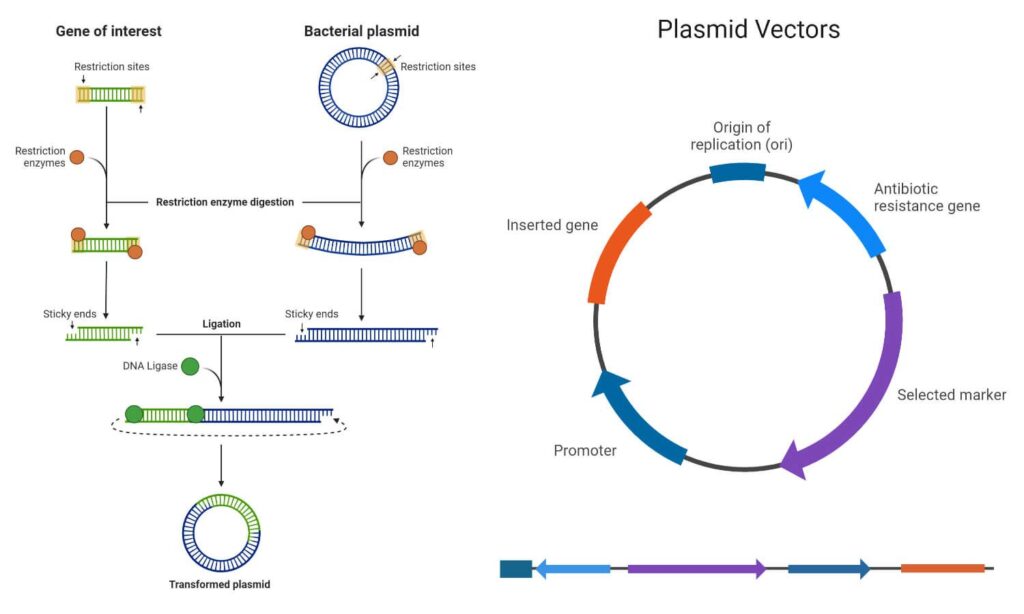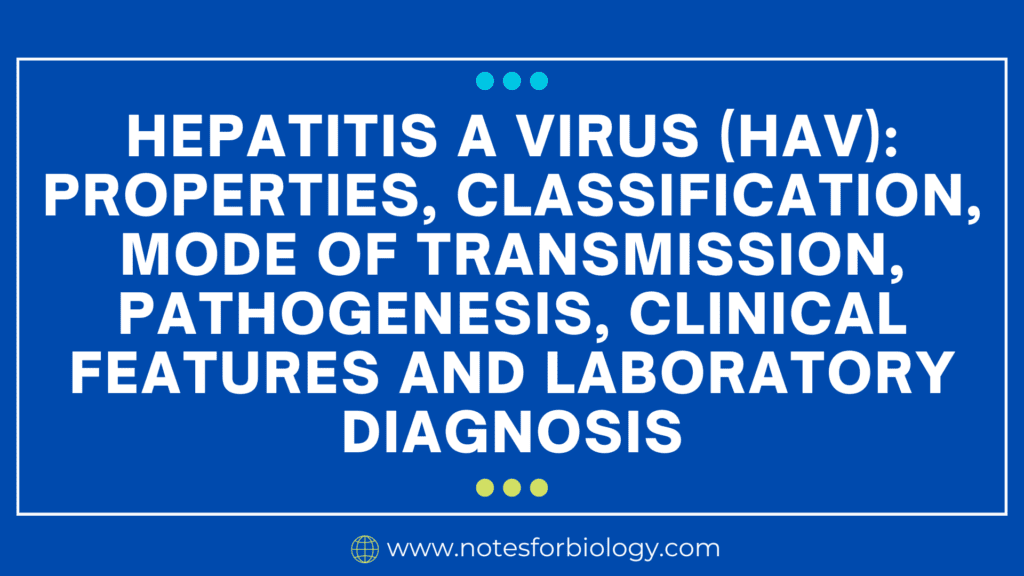Introduction
DNA cloning, also known as molecular cloning or gene cloning, is a fundamental technique in molecular biology that allows scientists to create many identical copies of a specific DNA fragment. Whether the purpose is to study a gene, produce a protein, or develop genetically modified organisms, DNA cloning plays a central role.
It is widely used in medical research, biotechnology, genetic engineering, synthetic biology, and more. This technique has helped us produce insulin, make disease-resistant crops, and even explore cures for genetic disorders.

In this document, we will explore the principle, components, step-by-step process, different methods, and wide-ranging uses of DNA cloning.
Table of Contents
Principle of DNA Cloning
The basic principle of DNA cloning is to insert a DNA fragment of interest into a carrier molecule called a vector, which is then introduced into a host organism. This recombinant DNA is replicated every time the host cell divides, producing many copies of the DNA fragment.
The success of DNA cloning relies on key tools:
- Restriction enzymes to cut DNA at precise sites
- Vectors to carry the DNA fragment
- Host cells to replicate the recombinant DNA
- DNA ligase to glue the DNA pieces together
Key Components of DNA Cloning

DNA of Interest (Insert)
This is the specific DNA fragment or gene that scientists want to isolate and clone. It could be a gene for insulin, a fluorescent protein, or any other segment of DNA.
Restriction Enzymes
These are molecular scissors that cut DNA at specific sequences called restriction sites. Using the same enzyme on both the insert and the vector ensures compatible ends for joining.
Vectors
Vectors are DNA molecules that carry the insert into the host cell. Common vectors include:
- Plasmids (circular DNA in bacteria)
- Bacteriophages (viruses that infect bacteria)
- Cosmids, BACs (Bacterial Artificial Chromosomes), and YACs (Yeast Artificial Chromosomes)
DNA Ligase
An enzyme that joins DNA fragments together by forming phosphodiester bonds between the sugar-phosphate backbones of DNA.
Host Cells
These are living cells, usually Escherichia coli (E. coli), that receive the recombinant DNA and replicate it along with their own DNA.
Selectable Marker Genes
Marker genes like antibiotic resistance help identify which cells have taken up the recombinant vector. Cells without the vector will not survive on selective media.
Steps in DNA Cloning

Step 1: Isolation of DNA
The gene of interest is isolated from the source organism. The DNA is then purified to remove proteins and other cellular debris.
Step 2: Cutting DNA with Restriction Enzymes
Both the source DNA and the vector are treated with the same restriction enzyme to create compatible ends for insertion.
Step 3: Inserting DNA into the Vector
The DNA fragment is inserted into the vector, and DNA ligase is used to seal the gap, creating a recombinant DNA molecule.
Step 4: Introduction into Host Cell
This recombinant DNA is introduced into competent host cells through a process known as transformation.
Common Transformation Methods
- Chemical transformation: Using calcium chloride and heat shock
- Electroporation: Using electric pulses to open pores in the cell membrane
- Microinjection and gene gun for more complex organisms
Step 5: Selection of Transformed Cells
Cells are grown on selective media containing antibiotics. Only those with the recombinant vector will grow due to the presence of a selectable marker gene.
Step 6: Cloning and Amplification
As the selected bacterial colonies grow and divide, they make copies of the recombinant DNA along with their own.
Step 7: Screening and Confirmation
Colonies are tested to confirm successful cloning. Techniques such as PCR, restriction digestion, or DNA sequencing are used.
Methods of DNA Cloning
Traditional Restriction-Ligation Cloning
Uses restriction enzymes and ligase to insert DNA into a vector. It’s widely used but limited by the availability of restriction sites.
PCR Cloning
Uses PCR to amplify the DNA fragment before inserting it into a vector. This method is fast and does not require restriction enzymes.
TA Cloning
Taq polymerase adds an “A” tail to the PCR product, which matches the “T” overhang on special vectors. Quick and efficient.
TOPO Cloning
Utilizes topoisomerase enzymes to join DNA ends. No ligase required, making it convenient for many labs.
Gateway Cloning
Uses site-specific recombination to move DNA between different vectors. Ideal for high-throughput cloning.
Gibson Assembly
Allows seamless assembly of multiple DNA fragments in one reaction. Commonly used in synthetic biology.
Golden Gate Assembly
Uses Type IIS restriction enzymes to join multiple DNA fragments in a specific order. Great for building synthetic pathways.
Applications and Uses of DNA Cloning
Production of Therapeutic Proteins
Recombinant DNA cloning is used to make:
- Human insulin
- Growth hormone
- Erythropoietin (for anemia)
- Monoclonal antibodies
- Vaccines (e.g., hepatitis B)
Gene Therapy
Cloned genes are used to treat inherited diseases by replacing faulty genes with functional ones.
Genetically Modified (GM) Crops
Used to create:
- Insect-resistant crops (Bt corn)
- Drought-tolerant plants
- Enhanced nutrition (Golden rice)
Scientific Research
DNA cloning is crucial in understanding:
- Gene expression
- Protein function
- Genetic mutations
- Regulatory sequences
Forensic Applications
Helps in:
- Identifying individuals
- Solving crimes
- Paternity testing
Industrial Enzyme Production
Enzymes like cellulases, proteases, and lipases used in:
- Detergents
- Food processing
- Biofuels
Transgenic Organisms
Animals and plants are engineered using cloned genes to study diseases or improve traits.
Synthetic Biology
Scientists use DNA cloning to build new biological circuits and custom organisms for innovation.
Diagnosis of Genetic Disorders
Cloning helps detect mutations that cause diseases like cystic fibrosis, sickle cell anemia, and certain cancers.
Conservation Biology
Preserves genetic material of endangered species and aids in their reproductive technologies.
Limitations and Challenges of DNA Cloning
Ethical Concerns
Particularly in cloning whole organisms or using human genes.
Technical Barriers
- Difficulty cloning large or unstable DNA
- Risk of mutations during amplification
- Contamination risks in laboratory
Environmental and Health Risks
Use of antibiotic resistance genes may spread to non-target organisms.
Cost and Time
Cloning complex constructs may require expensive reagents and weeks of effort.
Future of DNA Cloning
With advancements in gene editing tools like CRISPR-Cas9, and synthetic DNA technologies, cloning is becoming more precise, faster, and cheaper. Future uses may include:
- Personalized medicine based on individual genomes
- Custom microbes for environmental cleanup
- Creation of synthetic life forms
The integration of AI and robotics in synthetic biology will further automate and scale cloning efforts.
Conclusion
DNA cloning is one of the most transformative techniques in modern science. From producing life-saving medicines to creating drought-resistant crops, it has countless applications. The basic idea—cutting, pasting, and replicating DNA—has enabled breakthroughs across medicine, agriculture, and biotechnology.
By understanding its principles, components, steps, and methods, we get a clearer view of how life can be studied and reshaped at the molecular level. Though challenges remain, the responsible use of DNA cloning holds the potential to solve many of humanity’s pressing problems.
Three Key Summary
- DNA cloning involves inserting a gene of interest into a vector, introducing it into a host, and allowing it to replicate.
- Tools like restriction enzymes, ligase, vectors, and host cells are essential for successful cloning.
- DNA cloning is widely used in medicine, research, agriculture, industry, and synthetic biology.
FREQUENTLY ASKED QUESTIONS
What is the difference between DNA cloning and PCR?
PCR is an in vitro technique to amplify DNA without a host cell. DNA cloning involves inserting DNA into a host organism for replication.
Is DNA cloning the same as cloning an organism?
No. DNA cloning deals with replicating genes or DNA segments, while organism cloning (like cloning a sheep) creates an entire new organism.
Is DNA cloning safe?
Yes, it is generally safe when conducted in laboratories with proper biosafety guidelines. However, its applications should be monitored ethically.
Related Articles




